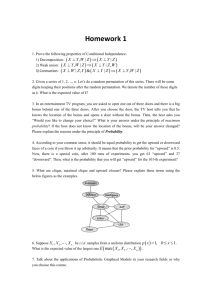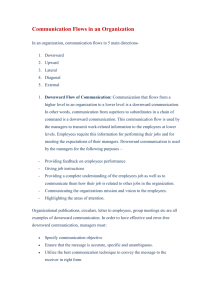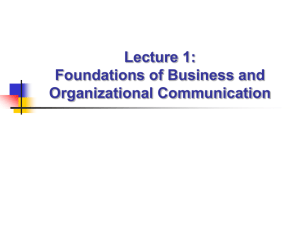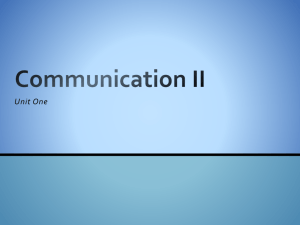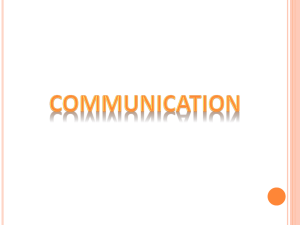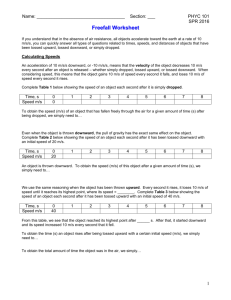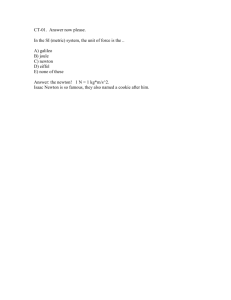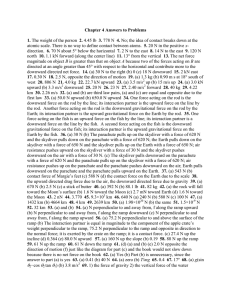Chapter 08
advertisement
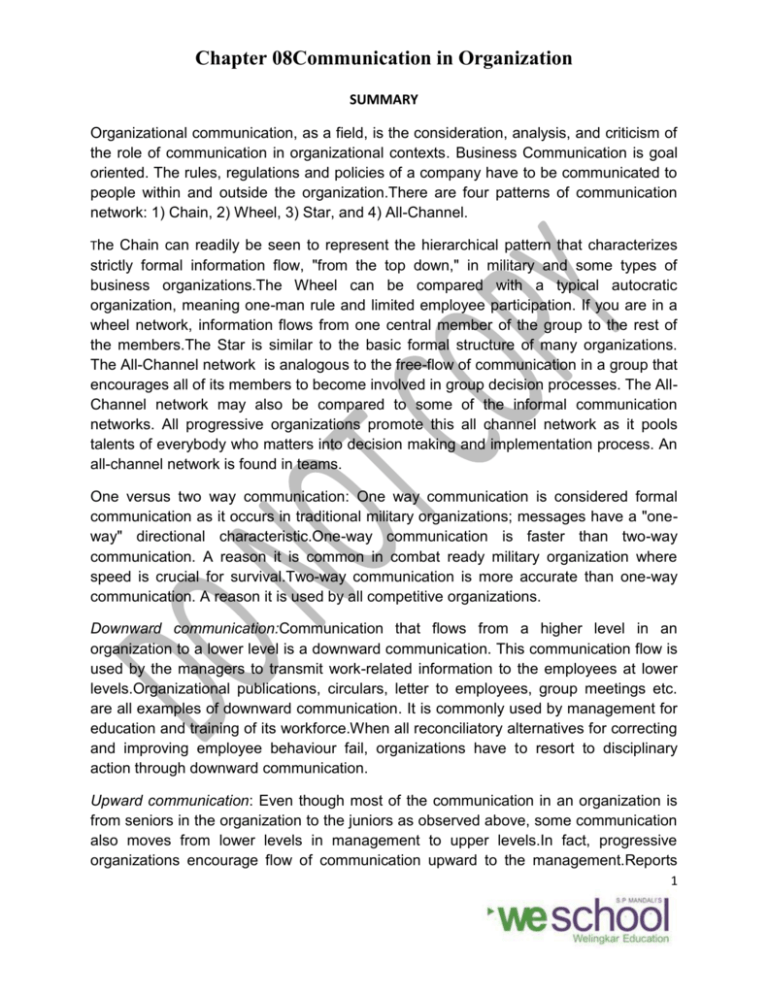
Chapter 08Communication in Organization SUMMARY Organizational communication, as a field, is the consideration, analysis, and criticism of the role of communication in organizational contexts. Business Communication is goal oriented. The rules, regulations and policies of a company have to be communicated to people within and outside the organization.There are four patterns of communication network: 1) Chain, 2) Wheel, 3) Star, and 4) All-Channel. The Chain can readily be seen to represent the hierarchical pattern that characterizes strictly formal information flow, "from the top down," in military and some types of business organizations.The Wheel can be compared with a typical autocratic organization, meaning one-man rule and limited employee participation. If you are in a wheel network, information flows from one central member of the group to the rest of the members.The Star is similar to the basic formal structure of many organizations. The All-Channel network is analogous to the free-flow of communication in a group that encourages all of its members to become involved in group decision processes. The AllChannel network may also be compared to some of the informal communication networks. All progressive organizations promote this all channel network as it pools talents of everybody who matters into decision making and implementation process. An all-channel network is found in teams. One versus two way communication: One way communication is considered formal communication as it occurs in traditional military organizations; messages have a "oneway" directional characteristic.One-way communication is faster than two-way communication. A reason it is common in combat ready military organization where speed is crucial for survival.Two-way communication is more accurate than one-way communication. A reason it is used by all competitive organizations. Downward communication:Communication that flows from a higher level in an organization to a lower level is a downward communication. This communication flow is used by the managers to transmit work-related information to the employees at lower levels.Organizational publications, circulars, letter to employees, group meetings etc. are all examples of downward communication. It is commonly used by management for education and training of its workforce.When all reconciliatory alternatives for correcting and improving employee behaviour fail, organizations have to resort to disciplinary action through downward communication. Upward communication: Even though most of the communication in an organization is from seniors in the organization to the juniors as observed above, some communication also moves from lower levels in management to upper levels.In fact, progressive organizations encourage flow of communication upward to the management.Reports 1 Chapter 08Communication in Organization that make you look competent and professional use upward communication. So do employee suggestion schemes. You may need additional resources (money, staff, authority, access to information) to complete your project. This is perhaps the most difficult area of upward communication. It is also used for reporting problems, concerns and complaints. Theadvantages of upward communication include friendly relations among the workgroups, valuable feedback, participation by motivated workforce, their suggestions, ideas for new projects and general boost to morale. Disadvantages of upward communication cover employee resistance to communicate, fear of incompetence, indecisive superiors and failure to hear messages. In today's information age, communication is multi-directional and purposeful...it goes anywhere and goes where it is needed. Lateral communication is defined as the exchange, imparting or sharing of information, ideas or feeling between people within a community, peer groups, departments or units of an organization who are at or about the same hierarchical level as each other for the purpose of coordinating activities, efforts or fulfilling a common purpose or goal.This communication may take place as telephone calls, e-mails, memos, letters, informal discussions, gossip, teleconferencing, videoconferencing, second life conferencing, and meetings set up by the group.To improve horizontal communication, knowing the audience is essential for speakers who should be fluent, use proper pronunciation and be coherent. Communication that takes place between a manager and employees of other workgroups is called diagonal communication. It generally does not appear on organizational chart. External communication is a field that covers the wide variety of methods that a company may use to catch the public’s attention. In certain cases, companies utilize interactive external communication methods, allowing the public to voice opinions and concerns. Its objectives are building public image, creating positive customer perception, attracting potential employees, securing finance at preferred terms. Company website, press release, email and newsletters, telephone calls, media interviews and press conferences are main media of external communication. Each business web site has critical pages on:- Contact Us, Request a Quote, Location, Home Page, Splash Page, About Us, Products, Testimonials, News, Events, Partners, Distributors, Solutions, Markets, FAQs, Company Outline, Knowledge Base, 2 Chapter 08Communication in Organization Management Team website functions: ...and so on.Each business web site carries following critical Search Function, Secure Web Pages, Banner Types, RSS and ATOM Feeds, Blog, Forums, Contact Forms, Workflow Forms, Live Chat, Calendar, File Download and Uploads, Galleries, Website Skin / Theme, Site Maps as well as Google Maps. Press release consists of written or recorded statements that a company distributes to media outlets such as newspapers and radio stations. These releases are required to contain strictly newsworthy information regarding company services and products.Websites have changed the way press releases are submitted. Commercial, fee-based press release distribution services, such as news wire services, or free website services co-exist, making news distribution more affordable and leveling the playing field for smaller businesses.The use of press releases is common in the field of public relations (PR). Typically, the aim is to attract favorable media attention to the PR professional's client and/or provide publicity for products or events marketed by those clients. A company can release mass emails to a target audience such as consumers or shareholders. These emails can also take the form of electronic newsletters that the company distributes on a regular basis.A company can use telephone calls to reach individuals in its target audience. These calls may consist of prerecorded messages offering sales information and opportunities. This strategy may cross into the field of telemarketing, in which services are offered directly through telephone calls.Customer retention is crucial for every successful brand, and a live answering service is one of the best ways a company can ensure that its clients stay satisfied. A company can arrange media interviews and press conferences to announce or to respond to emergency issues. Journalists attend these media events so they can ask questions, make comments and record data for later reports.Organizations also maintain business communication with customers and public via newspaper, magazine advertisements and insertions. Externalcommunication is importantbecause it creates a strong identity. Consistent external communication helps businesses create a unique and desirable public identity, both to consumers and other professionals. Further it establishes thought leadership.External communication establishes your organization as a leading light in your business sector. By positioning yourself as thought leader in your industry, potential employees, clients and business partners will look up to your company for 3 Chapter 08Communication in Organization guidance in case of problems in the industry or shifts in market dynamics.Next it beats competition. When you start a business, you are a small fish in a big pond. Whichever sector you are in, there will be a lot of competitors who are both more established than you, and who are already using PR. You need an external communications strategy to compete with them and to communicate effectively with the market. You need to be able to bestow legitimacy among target markets, investors and stakeholders. 4

